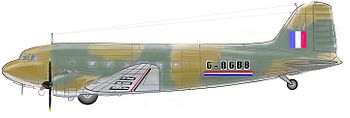BOAC Flight 777

Artist's impression of G-AGBB
|
|
| Accident summary | |
|---|---|
| Date | 1 June 1943 |
| Summary | Attacked by eight German Junkers Ju 88 fighters of KG 40, crashed into the sea |
| Site |
Bay of Biscay, off the coast of Spain and France 46°07′00″N 10°15′00″W / 46.116667°N 10.25°WCoordinates: 46°07′00″N 10°15′00″W / 46.116667°N 10.25°W |
| Passengers | 13 |
| Crew | 4 |
| Fatalities | 17 (all) |
| Survivors | 0 |
| Aircraft type | Douglas DC-3-194 |
| Aircraft name | Ibis |
| Operator | British Overseas Airways Corporation, (owner KLM) |
| Registration | G-AGBB |
| Flight origin | Lisbon Portela Airport, Portugal |
| Destination | Bristol (Whitchurch) Airport, United Kingdom |
BOAC Flight 777-A was a scheduled British Overseas Airways Corporation civilian airline flight from Portela Airport in Lisbon, Portugal, to Whitchurch Airport near Bristol, England, on 1 June 1943. It was attacked en route by eight German Junkers Ju 88s and crashed into the Bay of Biscay, resulting in the deaths of all 17 on board. There were several notable passengers, amongst them actor Leslie Howard.
Theories abound that the aircraft, a Douglas DC-3, was attacked because the Germans believed that British Prime Minister Winston Churchill was aboard. Other theories suggest the DC-3 was targeted because several passengers, including Howard, were British spies. During the Second World War, British and German civilian aircraft operated out of the same facilities at Portela and the incoming and outgoing traffic was watched by Allied and Axis spies. The Lisbon–Whitchurch route frequently carried agents and escaped POWs to Britain.
While aircraft flying the Lisbon–Whitchurch route were left unmolested at the beginning of the war, and both Allied and Axis powers respected the neutrality of Portugal, the air war over the Bay of Biscay, north of Spain and off the west coast of France, had begun to heat up in 1942, and the Douglas DC-3 lost in this attack had twice survived attacks by Luftwaffe fighters in November 1942 and April 1943.
When war broke out in Europe, the British Air Ministry prohibited private flying and most domestic air services. Imperial Airways and British Airways Ltd, in the process of being merged and nationalised as BOAC, were evacuated from Croydon Aerodrome and Heston Aerodrome to Whitchurch, outside Bristol. After the fall of Norway, the Netherlands, Belgium and France, and Italy's entry to the war, only Sweden, Ireland and Portugal remained as European destinations for BOAC (the US was just within range of BOAC's Empire flying boats by refuelling in Newfoundland). Over the UK, civil aircraft were restricted to between 1,000 and 3,000 feet (300 and 910 m) and could only fly during daylight to ease identification. The British government also restricted flights to diplomats, military personnel, VIPs, and those with government approval.
...
Wikipedia
